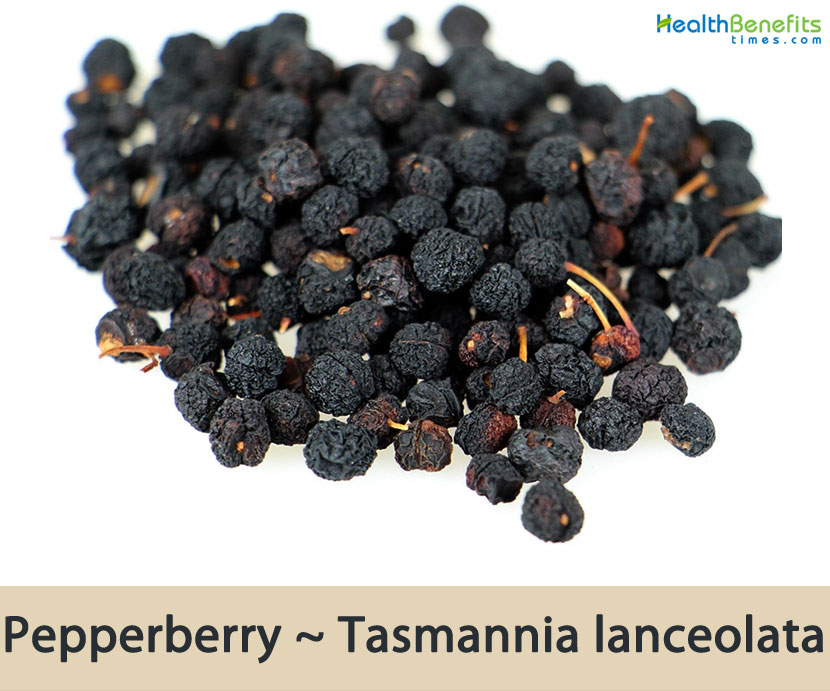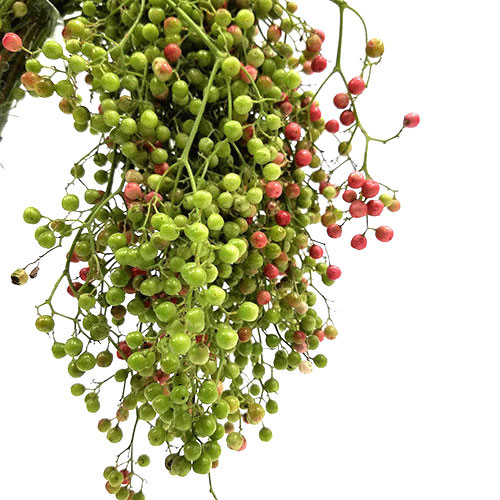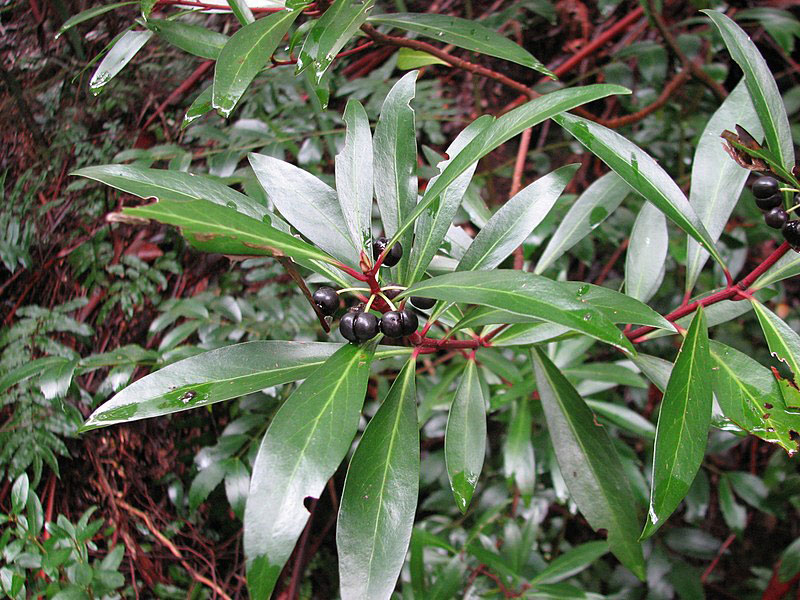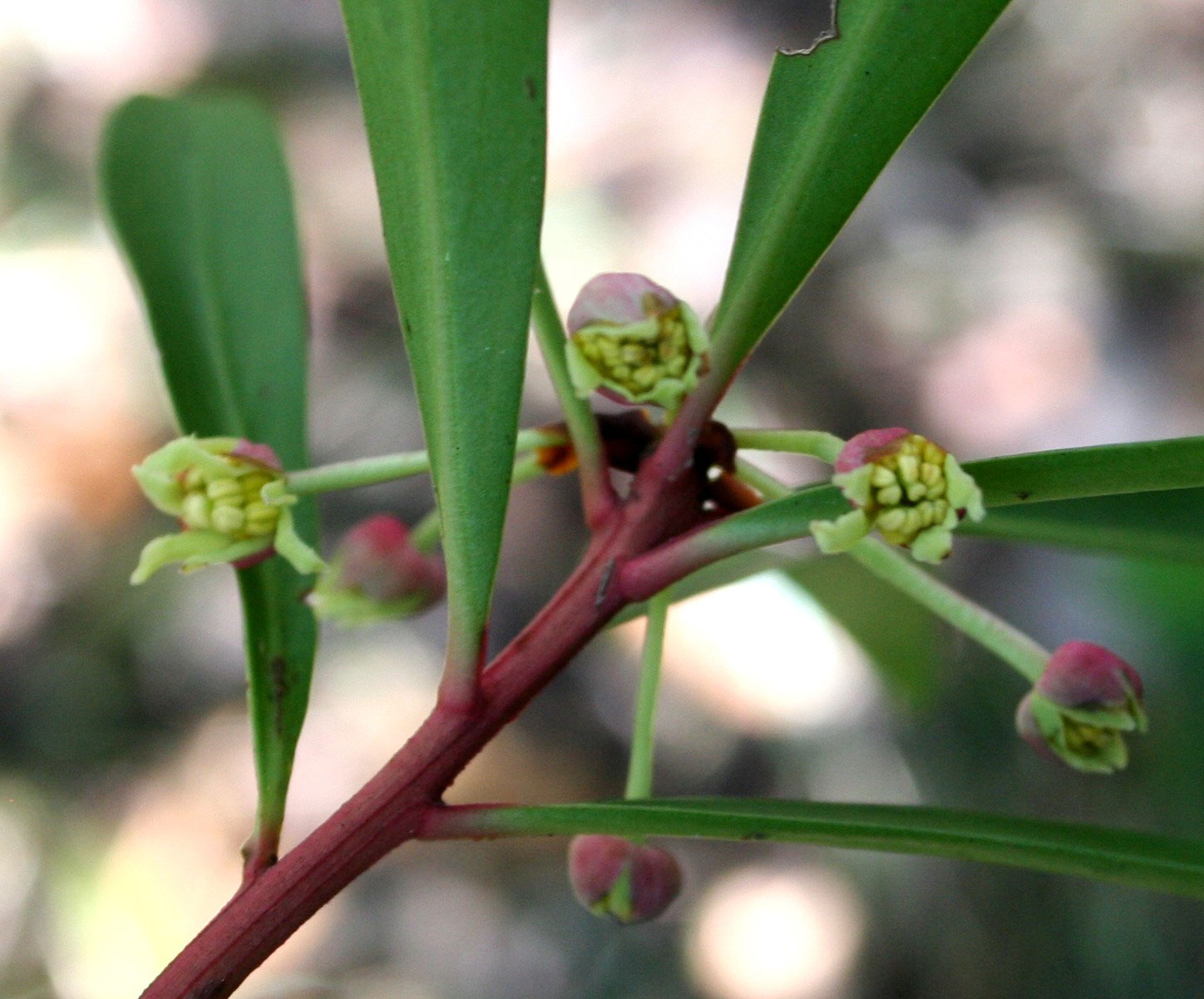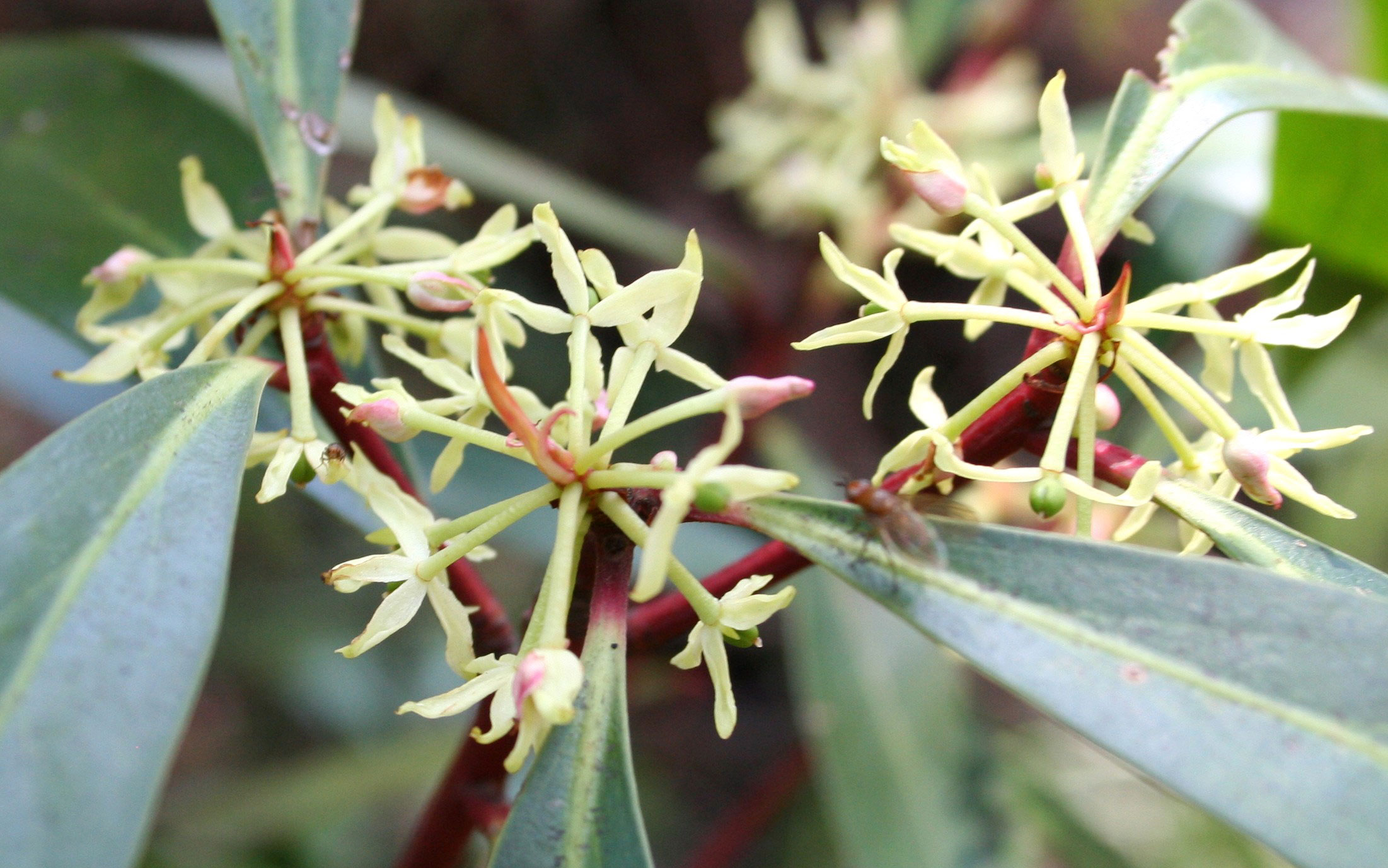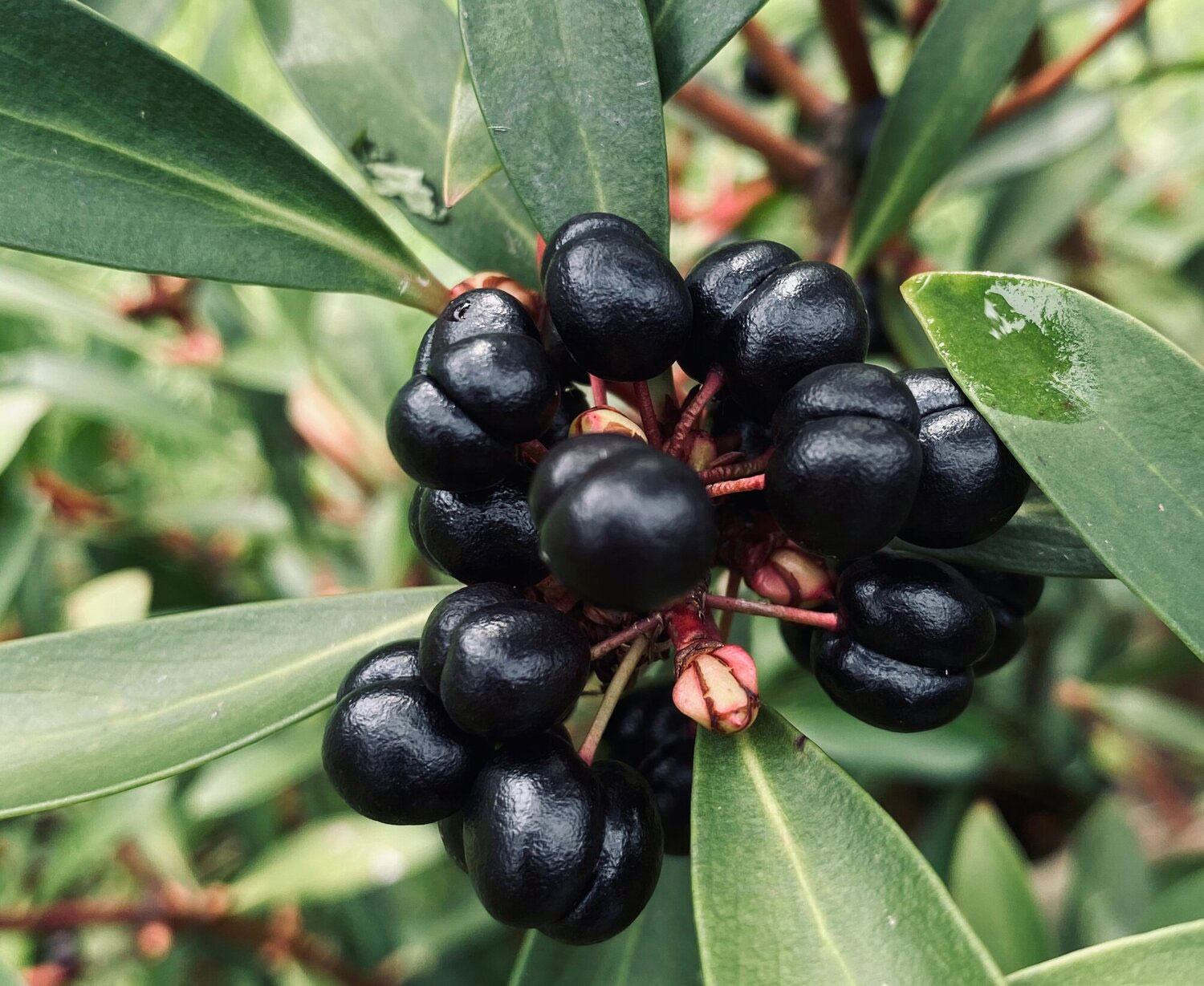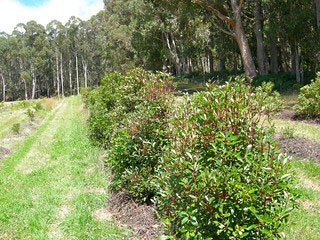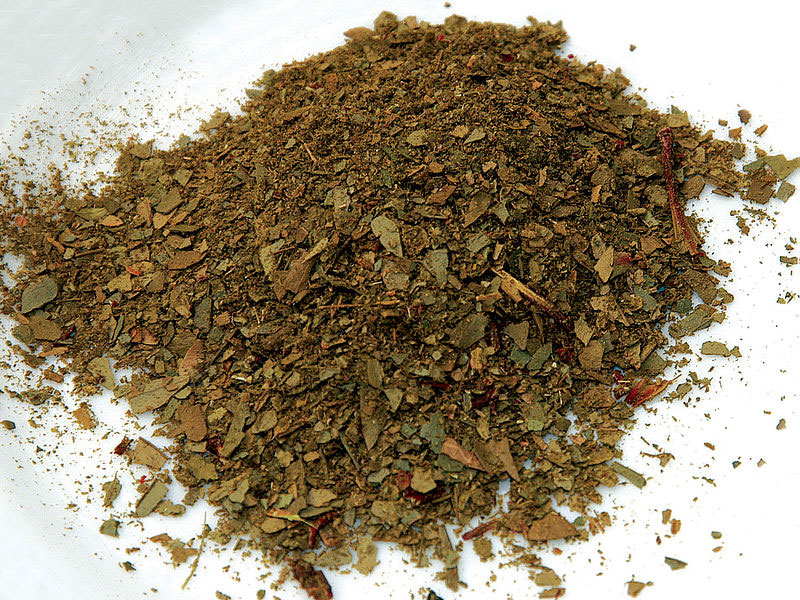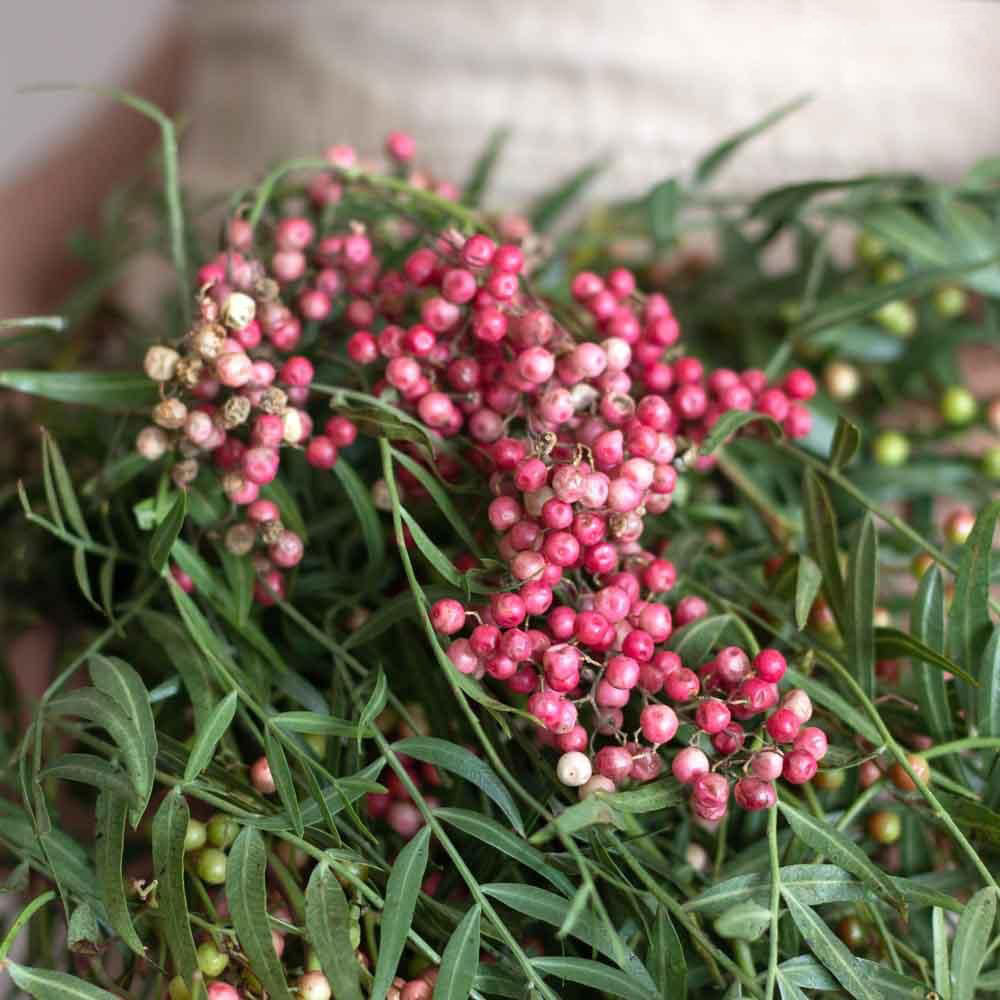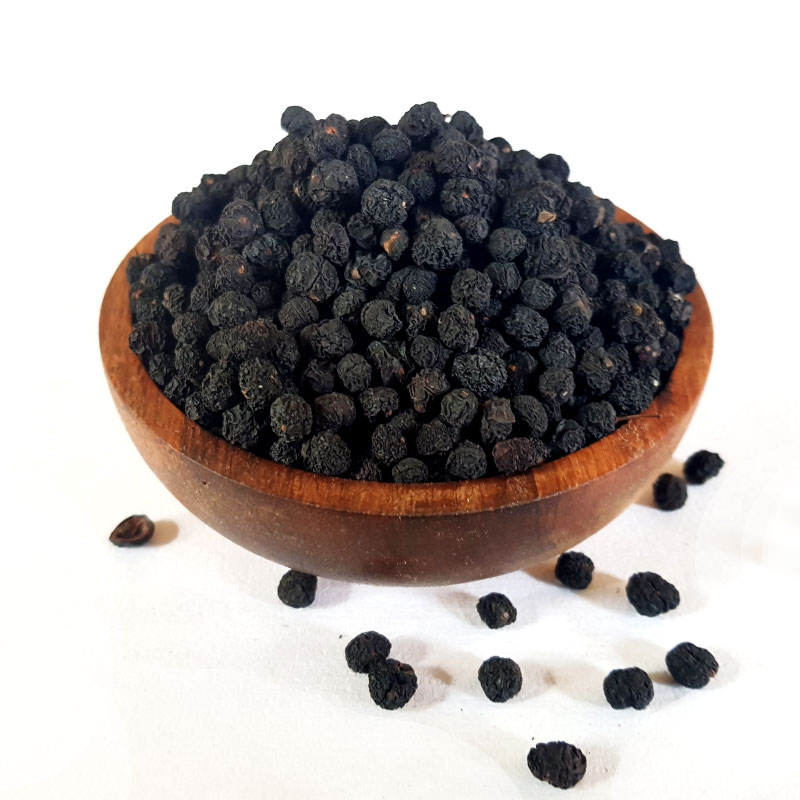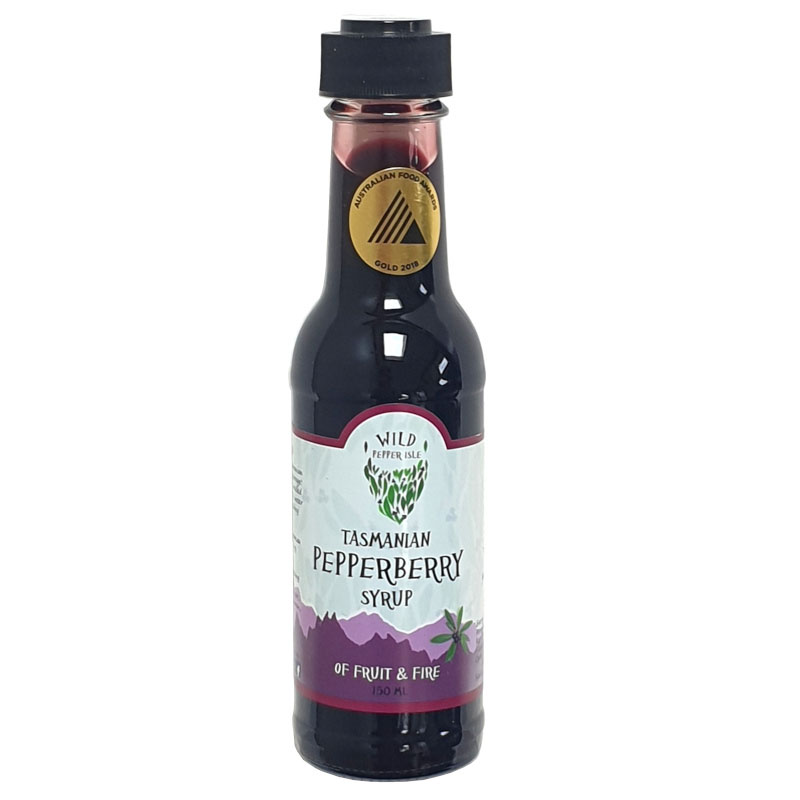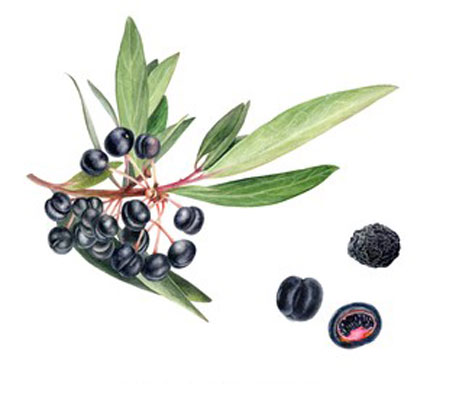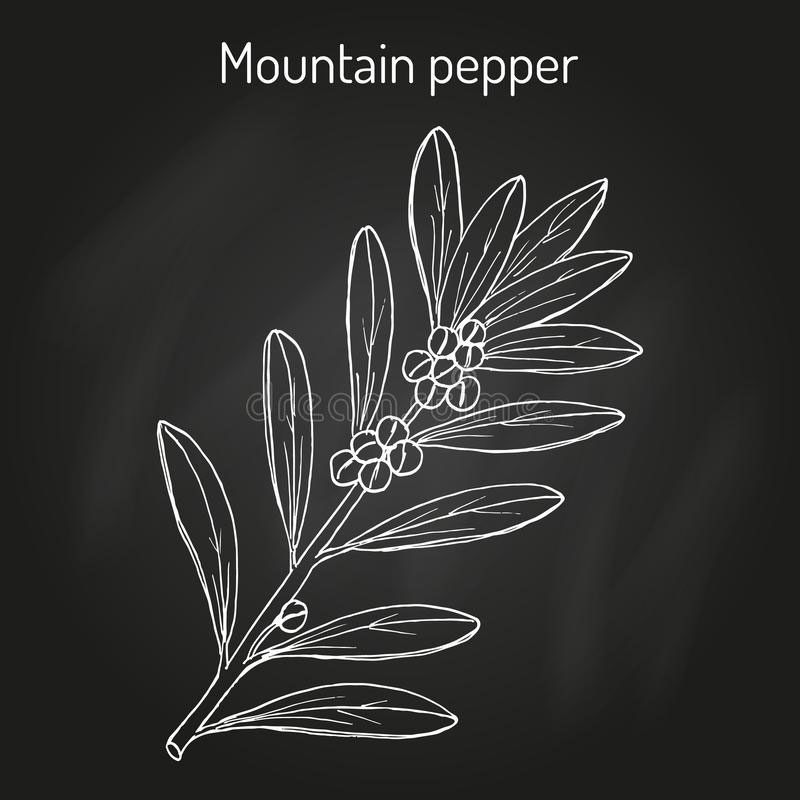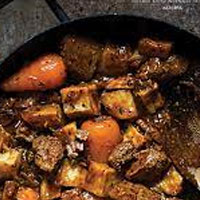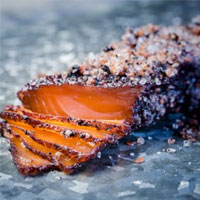The mountain pepper plant is used both ornamentally and in food preparation, and the tree produces two products: the berry and the leaf. Berries are dark-blue to black in color and have a sweet, aromatic peppery taste. Leaves, stems and berries produce around three times the antioxidants of blueberries. The Tasmanian Pepper is known and available in Australia only, where it plays an increasing role in local cookery. It is used for typical Australian food, e. g. emu hamburger or kangaroo steaks. It is common to marinate meat with a mixture of crushed Tasmanian pepper berries and vegetable oil before grilling or frying. Stews with longer cooking period, on the other hand, are seasoned with the ground grains before serving, because long simmering destroys the taste of this spice.
Pepper Berry Facts
| Pepper berry Quick Facts | |
|---|---|
| Name: | Pepper berry |
| Scientific Name: | Tasmannia lanceolata |
| Origin | Cooler New South Wales, from Barringt in the cooler South-Eastern parts of Australia, such as Tasmania, New South Wales and Victoria |
| Colors | Green becoming dark purplish-red to black when ripe |
| Shapes | Globose to subglobose two-lobed berry, 5–8 mm across containing numerous, 10–18 small seeds. |
| Taste | Initially earthy, sweet and fruity on the front palate with an intense spicy, peppery notes that build and linger on the back palate |
| Health benefits | Reduces dark circles, Protection against Premature Ageing, Prevents Mutation of Cells, Helpful For People Suffering from Level 2 Diabetes,Prevent Stomach Issues, Possess Anti-Inflammatory Properties |
| Name | Pepper berry |
|---|---|
| Scientific Name | Tasmannia lanceolata |
| Native | Cooler New South Wales, from Barringt in the cooler South-Eastern parts of Australia, such as Tasmania, New South Wales and Victoria |
| Common Names | Cornish Pepper Leaf, Mountain Pepper, Mountain Pepperbush, Tasmanian Pepperberry, Tasmanian Pepper Bush, Cornish pepper, mountain pepperleaf, mountain pepperberry, Dorrigo pepper, Peppertree |
| Name in Other Languages | English: Mountain Pepper, Peppertree, Tasmanian pepperberry French : Poivre indigène German : Australischer Pfeffer, Bergpfeffer, Tasmanischer Pfeffer, Pfefferbaum Swedish: Tasmaniepeppar |
| Plant Growth Habit | Dense shrub to a medium evergreen dioecious tree |
| Growing Climates | Moist woodlands, moist eucalypt forest, gullies and cool temperate mountain rainforest |
| Soil | Neutral to slightly acid soil, preferably well-drained and fertile |
| Plant Size | 6-30 ft. (2-10 m) tall |
| Stem | Young stem and branches are bright red to purple-red in color |
| Leaf | Alternate and borne on 2–4 mm thick, red petioles. Lamina is lanceolate to narrow-elliptic, 4–12 cm long by 0.8–2 cm wide, with acuminate apex, tapering base and entire margin, thick, glabrous, glossy green above and paler green below. Leaves are aromatic when crushed |
| Flowering season | April to May |
| Flower | Small, white to creamy white, 1–2 cm across and borne on short 5–15 mm pedicel; each flower arises from the axil of a bud scale, forming bunches of eight to ten flowers that look like a small terminal umbel. Flower perianth in 2 whorls, outer 2–3 sepal-like lobes which are shed after anthesis and inner 4–8 strap shaped petal lobes. Male flower has 20–25 stamens and female flower has a solitary carpel |
| Fruit Shape & Size | Globose to subglobose two-lobed berry, 5–8 mm across containing numerous, 10–18 small seeds |
| Fruit Color | Green becoming dark purplish-red to black when ripe |
| Flavor/Aroma | Oily, mineral-like, turpentine aroma |
| Taste | Initially earthy, sweet and fruity on the front palate with an intense spicy, peppery notes that build and linger on the back palate |
| Plant Parts Used | Leaves |
| Propagation | By seeds and stem cuttings |
| Season | September to October |
| Health Benefits |
|
| Precautions |
|
Plant Description
Pepper berry is a dense shrub to a medium evergreen dioecious tree that normally grows about 6-30 ft. (2-10 m) tall. The plant is found growing in moist woodlands, moist eucalypt forest, gullies and cool temperate mountain rainforest. The plant grows on neutral to slightly acid soil, preferably well-drained and fertile soil. Young stem and branches are bright red to purple-red in color.
Leaves
Leaves are alternate and borne on 2–4 mm thick, red petioles. Lamina is lanceolate to narrow-elliptic or oblanceolate, 4–12 cm long and 0.8–2 cm wide, with acuminate apex, tapering base and entire margin, thick, glabrous, glossy green above and paler green below. Leaves are aromatic when crushed.
Flower
Flowers are small, white to creamy white, 1–2 cm across and borne on short 5–15 mm pedicel. Each flower arises from the axil of a bud scale, forming bunches of eight to ten flowers that look like a small terminal umbel. Flower perianth in 2 whorls, outer 2–3 sepal-like lobes which are shed after anthesis and inner 4–8 strap shaped petal lobes. Male flower has 20–25 stamens and female flower has a solitary carpel. Flowering normally takes place in between April to May.
Fruit
Fertile flowers are followed by black, globose to subglobose two-lobed berry, 5–8 mm across containing numerous, 10–18 small seeds. The fruit starts off dark red in color and turns black on ripening. Only the female trees bear fruit. It has a unique fruity flavor, fragrant eucalypt/ menthol/ fruity aroma, and a characteristically delayed but intense peppery heat. Mountain pepper has a sweet taste and an intense, peppery aftertaste from which they get their name.
Berries, leaves and bark of this species have historical uses as a food and as a medicinal plant. When the berry is air dried it forms a small, hard peppercorn which is appropriate for milling or crushing. The berry has a pleasant spicy flavor and sharp aroma. Historically, the leaves have been used as an herb and the berries have been used as a spice.
Health benefits of Pepper berry
Listed below are some of the popular health benefits of Pepper berry
1. Possess Anti-Inflammatory Properties
The pepper has been known extensively for curing several sorts of inflammation within and outside the body. It has been known very widely for curing symptoms as well as side effects related to arthritis.
2. Prevent Stomach Issues
Pepper berry is known to contain compound named as polygodial which is known to prevent stomach lining from deteriorating and therefore is also known to possess anti-pain property.
3. Helpful For People Suffering from Level 2 Diabetes
Certain compounds present in this berry have been known to facilitate slow absorption of glucose from the stomach and therefore this leads to reduction in levels of diabetes in patients.
4. Prevents Mutation of Cells
Pepper berry has been known to prevent conversion of healthy cells in cancer ones and hence it reduces the chances of people to have the problem of cancer.
5. Protection against Premature Ageing
Antioxidants are an essential part of equipping ourselves with the right ‘armor’ to combat against the elements that stimulate free radicals that eventually lead to premature ageing. Naturally occurring Vitamins C and E act as energy and fuel for your skin. Not only will you be protecting and preserving your skin, along with a well-formulated sunscreen, but the antioxidants of this berry may also soothe, brighten and revive dull-looking skin.
6. Reduces dark circles
Dark circles are caused by the thinning of the skin under the eyes leaving red blood vessels and capillaries exposed. Rutin is a flavonoid that helps regenerate cells to strengthen the outer layer of skin and reduce the visibility of dark circles helping you look more energized and yes, dare we say it…radiant!
Traditional uses and benefits of Pepper berry
- During the early colonial days in Australia, mountain pepper had been used in medicine as a stomachic, scurvy and as a substitute for winter’s bark.
- In traditional medicine it is used as a treatment for skin disorders, venereal diseases, colic and stomach ache.
- Indigenous Australians suffering from sore gums and toothaches often crushed the berries with water to make a paste, which was then applied to the mouth to treat the infection.
- Crush the berries with water to make a paste and apply directly to treat any infection.
- Traditionally it has been used by medical practitioners for arthritis problems.
- It is highly useful for diabetes patients; it also prevents the types of mutation of genetic material.
- Pepper berry is used to promote skin elasticity, minimizes wrinkles, supports dermal density, and stimulates collagen production and evens skin tone & texture.
- It is very high in antioxidants and has been used to improve digestion and treat digestive disorders.
- Tasmanian Mountain Pepper leaf and berries have a very strong antimicrobial activity against common food born human pathogens, bacteria, yeasts and molds.
- Lutein is important for eye health and the prevention of macular degeneration.
- Its anti-allergic property is effective in treating various allergic reactions on the skin.
- Its anti-inflammatory property soothes skin inflammation caused due to sunburns.
- It contains a chemical compound – Rustin which is known to strengthen the capillaries and effectively reduce dark circles.
- Pepper berry is rich in antioxidants; it may prevent or delay cancer, diabetes and Alzheimer’s, as well as autoimmune and cardiovascular diseases.
- Pepper berries are used to assist in the slow absorption of glucose from the stomach, allowing for stabilization of blood sugar levels.
- Australian Aborigines also used T. lanceolata as a therapeutic agent to treat stomach disorders.
- Australian Aborigines use it for the treatment and cure of skin disorders, venereal diseases, colic, and stomach ache and as a quinine substitute.
Culinary Uses
- The peppery- flavored fruits, seeds and leaves when dried are increasingly used as a condiment in local cookery in Australia.
- It has been used by the aboriginals and early white-settlers as a pepper substitute.
- Mountain pepper is used for typical Australian cuisines, e.g. emu hamburger or kangaroo steaks; it is common to marinate meat with a mixture of crushed Tasmanian pepper berries and vegetable oil before grilling or frying.
- Stews with longer cooking period, are seasoned with the ground grains before serving, as long simmering destroys the taste of this spice.
- Mountain pepper is used to flavor curries, cheeses, alcoholic beverages, wines and salad dressings or ground as a substitute for black pepper.
- It is exported to Japan to flavor wasabi.
- Tasmanian pepper berry was used as a colonial pepper substitute.
- Flowers may be enjoyed fresh in salads, or as a pretty, peppery garnish for a variety of sweet and savory dishes.
- Leaves are dried and crushed and added to curries, pies, beef dishes and desserts.
- Pepper berries pair well with dairy (yoghurt, most cheese varieties, cream, ice cream and gelato/sorbet), oil and vinegar-based meat marinades and salad dressings, meat-based sauces and egg-based condiments.
- Mountain pepper berries lift the profile of alcoholic beverages such as gin, vodka, white rum, Cointreau and tequila.
- It adds a dark pinkish tint and refreshing, spicy twist to soda, tonic, mineral water and lemonade.
- Dried leaf is used as flakes but mostly milled for use as a spicy ingredient in flour mixes, relishes, sauces, mustards, soups, stews, small goods, cheeses and flavored pasta.
Slow cooked Pepper berry Wagyu (perfect for winter)
Ingredients
- 2 small red onions
- 1 carrot
- 1 stick of celery
- 1 red capsicum
- 2 cloves of garlic (crushed)
- 420gm cubed Wagyu Chuck Beef
- 1 Tablespoon Pepper berry – coarse ground of whole
- 2 Tablespoons Tomato Paste
- 1 cup of water
- 1 teaspoon Bush Tomato
Direction
- Dice the vegetables and place in the slow cooker, add garlic, beef, Pepper berry, Tomato paste and water.
- Mix well to combine.
- Slow cook for 7 hours.
- 10 minutes before serving add bush tomato seasoning and salt to taste.
- Serve with pasta, steamed beans and wild rocket salad.
Tasmanian Pepper berry Cured Huon Salmon
Ingredients
- 1 side Fresh Huon Salmon
- 1 cup Rock Salt
- 1/4 cup Tasmanian pepper berries
- 1/4 cup Fine salt (pure lake salt)
- 2 tbsp. Sugar
- 5 tbsp. White spirit – (Gin, vodka, aquavit, Willie Smiths schnapps)
Directions
- Place fine salt, pepper berries and sugar into a spice grinder or mortar and pestle and grind until fine.
- Mix with rock salt and spirit to form a rough paste.
- Lay cling wrap out on bench and spread 1/3 of the cure over the center of it.
- Place the salmon on top of the cure and spread the remaining salt cure over and around the fillet.
- Wrap cling wrap very tightly around fish and cure and add a few more cling wrap layers.
- Place into a container and sit a plate on top, weighted with something such as a dinner plate
- Sit in the refrigerator for 48 hours, turning every 12 hours or so. Salmon will be cured when it is firm to the touch.
- Remove from the fridge and container and wipe salt cure off.
- Then gently run a sharp knife under the skin to remove and slice salmon thinly to serve.
Other Facts
- Mountain pepper can be grown as a hedge in mild temperate areas and also makes an excellent windbreak in woodland.
- It can be grown as a garden plant.
- The pepper berry can be used as a fish poison.
- The leaves, fruits and even the fresh flower buds all have a distinct pepper berry aroma and taste, albeit at varying intensities.
References:
http://www.theplantlist.org/tpl1.1/record/tro-50108861
https://en.wikipedia.org/wiki/Tasmannia_lanceolata


